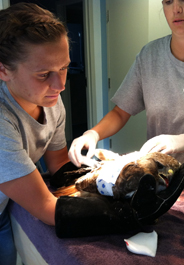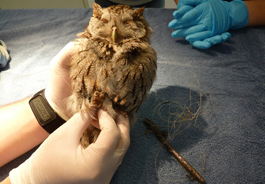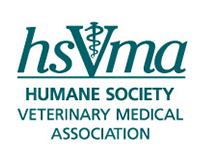Discovering My Path at the Cape Wildlife Centerby Cindy Hopf November 27, 2012  Veterinary student Cindy Chopf examines a red-tailed hawk at the Cape Wildlife Center. Deborah Millman/The HSUS I have spent time on Cape Cod with my grandparents every summer since I was a little girl. I treasure those summers, and the Cape will always hold a special place in my heart. This past summer, however, I got up close and personal with the wild animals of Cape Cod, and will never forget my experiences. I am now a second-year student at the Cummings School of Veterinary Medicine at Tufts University in Grafton, Mass. I came into veterinary school with little direction and unsure of my future. All I knew was that I wanted to help animals and people however I could, which is a rather broad goal. Being a persistent student and afraid of not having a direction, I started to dig into faculty profiles and the different departments at the School. I was aware that Tufts has an amazing wildlife center and incredible faculty, but didn't know until the middle of my first year how lucky I was to have them! By the second semester, I had found where I wanted to be. It was my comparative anatomy professor, Dr. Mark Pokras, who opened my eyes to the myriad species and opportunities involved in wildlife medicine. His class quickly became my favorite, and learning about wildlife just felt right. Dr. Pokras helped me find an internship position at the Cape Wildlife Center (CWC) in Barnstable, Mass. for the following summer. The Cape Wildlife Center, a facility operated by The Humane Society of the United States in partnership with The Fund for Animals, is dedicated to promoting and protecting the health and well-being of native wildlife and their habitats. This sounded pretty much perfect to me! I wasn't sure what to expect as I crunched down the gravel of the CWC's picturesque tree-lined drive, carrying the lunch that had been packed by my grandmother and my - mug of coffee. I was very quickly overwhelmed and excited by the size of the place, the beautiful facilities, and the friendly externs and staff. Shortly after I arrived, I was whisked around the center and the surrounding animal habitats by the very friendly and welcoming staff veterinarian at the CWC, Dr. Roberto Aguilar. I was initially worried that my lack of experience with wildlife would limit my role at the center, but I was very wrong. In my first week I was bottle feeding baby raccoons. In the second week I was swimming, fully-clothed, in the Cape Cod Bay in pursuit of an osprey who had crash-landed in the water. In the third week I was getting comfortable with how things ran at the center, and learning to never get comfortable handling or approaching a wild animal. The days started at 7 a.m. with feedings, and ended at around 6 or 7 p.m. with evening feedings. We rounded at 9 a.m. every morning to discuss the cases and animals in our care. I finally figured out where all of the enclosures were without having to walk around lost with bowls of bird seed, fruit, and kibble balancing in my hands. I also learned how quickly towels get dirty when your patients are wildlife and not immaculately-groomed pedigree dogs. I washed a lot of towels and pillow cases this summer. I do believe that I also improved my reflexes quite a bit -- between the birds flapping to get out of their enclosures and the raccoons squeezing themselves behind just about anything they could to avoid their rabies shot, I got pretty good with a net. I know it's quite a jump from running a washing machine to netting a feisty raccoon, but that's exactly what I learned wildlife medicine is: It's incredibly diverse and always surprising! I learned to tube-feed blue herons that had necks longer than my arm, and spent one lazy afternoon trying to document an oystercatcher eating. I nearly fell asleep when the bird decided I was no longer fun to watch, plopped down, and tucked his beak under his wing. One of my favorite activities was to sit around the front desk in between feedings and guess what the next cardboard box coming in the door held. If it was small, the vote was almost always for a bird; large was usually some small mammal like a squirrel or rabbit. But if it was animal control, all bets were off. Each box, cage, kennel, and sometimes just towels, held the next patient, and the other interns and I were always eager to help!  Cindy examines a Screech owl. Cindy Hopf None of the treatments, feedings, or observations compared to the excitement of a release. Near the end of my time at the CWC I got to see one of our Great Horned owls released into a Massachusetts Audubon sanctuary. There was a huge build-up discussion before the release, but once the top of the container was removed that owl took off in a huff of feathers and didn't take a second look back at the people that nursed him back to health. I'm not even sure anybody at the release was quick enough to catch a picture as he bolted out of the plastic bin and back into his world. Wildlife medicine is a very interesting field. You pour your time, energy, and heart in to animals with the sole purpose of tossing them back out in to the wild. It is for that reason that I love it. As much attention has to be given to the species as a population as to every individual animal. I learned that human and wildlife interactions happens everywhere and as they increase, it may mean more injured animals, curious people, complaints, or disease issues. Due to this increasing interaction, it is even more important to have well-educated veterinarians in the forefront monitoring medical rehabilitation and making progress in wildlife medicine. It is also important to have facilities where future veterinarians can learn about wildlife and the importance of humane treatment of wild animals. The Cape Wildlife Center is one of those places. I was lucky enough to experience all of these new things while learning from a fantastic veterinarian and teacher, and I will always be grateful for what Dr. Aguilar taught me. He was always patient and ready to teach instead of just show. He always made sure we maintained the right balance of safely and fun, which made for a great learning environment. The wildlife brought to the CWC is in compassionate and extremely capable hands. I was able to work with externs from all over the world, but regardless of our cultural differences, the animals were always put first- from the initial physical exam to radiographs, bandaging, and long-term treatment. Striving to provide these animals with a good quality of life was always our goal. I was easily convinced this summer that wildlife is my new direction. There really can't be that many places where you learn to stain blood smears in the morning, bandage bird wings before lunch, feed squash filled with snacks to raccoons in the afternoon, and wrap up the day with tube feeding a hawk or leading a parade of juvenile raccoons on their daily walk. Every animal I interacted with at the CWC left a lasting impression with me, and I will not soon forget the incredible staff and mentors at the CWC who continue to work and care for every patient.
 Cindy Hopf is in the class of 2015 at the Tufts University Cummings School of Veterinary Medicine and is currently serving as the school's HSVMA student chapter president. |
